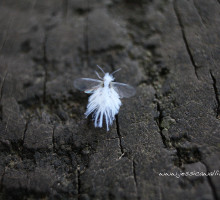
This delicate little creature is a woolly aphid in the subfamily Eriosomatinae (a Greek name that translates as “wool” + “body”). Often called “fairy flies”, these aphid-relatives are covered in white, waxy filaments that help camouflage them from predators and allow them to catch the wind and drift from primary to secondary host plants. Though many species of woolly aphid exist, one common species is the woolly apple aphid, a native of North America that uses apples and hawthorns as hosts. I found this fluffy little lady floating through a playground with a handful of her sisters. She graciously sat still for a few minutes so I could snap about a dozen images of her. Such a pretty little thing!

Mantidflies are in the family Mantispidae. This fascinating group of creatures aren’t actually flies at all – they are close relatives of lacewings. Their enlarged front legs are used to capture small insects for consumption, and their elongated prothroax makes them look a bit giraffe-like. This was the first mantidfly I’ve ever found in my garden, and I was completely fascinated by it. Mantidflies are largely nocturnal predators. The larvae of the subfamily to which this species of mantidfly likely belongs (Mantispinae) feed exclusively on spider eggs. You can’t get more beneficial than that in my book!